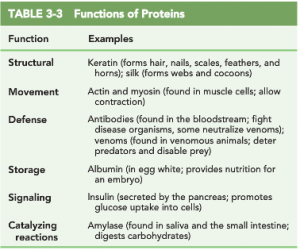Function of Protein
Protein Function
It is important to understand the relationship between protein structure and function. As we just learned, it is the exact sequence and poistion of the amino acids occuring in a polypeptide chain, along with the chemical differences between the variable functional groups found in each amino acid, that determine the final three-dimensional structure of each and every protein molecule. As it turns out, the precise three-dimensional structure of the protein molecule is primarily responsible for its overall function in the cell. To reinforce this, let’s consider the wide range of functions carried out by proteins inside of cells…

Examples
Table 3-3 in your text outlines some of the important functions performed by proteins along with examples of each type. Please note that these functions range from simple structural roles (such as those performed by keratin which strengthens our hair and skin) to complex enzymes which are used to carry out a variety of chemical reactions, including digestion, which involves the breakdown of larger macromolecules into their smaller subunits.

Protein Structure & Function
If we consider that proteins are very long chains of amino acids joined together through a series of peptide bonds, it becomes apparent that the sequence of amino acids will differ between each and every type of protein. It is estimated that there are over 100,000 different types of proteins found in the human body.
Summary
Proteins play a variety of roles in biological systems
- Structural roles; such as those performed by keratin which strengthens our hair and skin
- Complex enzymes; used to carry out a variety of chemical reactions, including digestion, which involves the breakdown of larger macromolecules into their smaller subunits